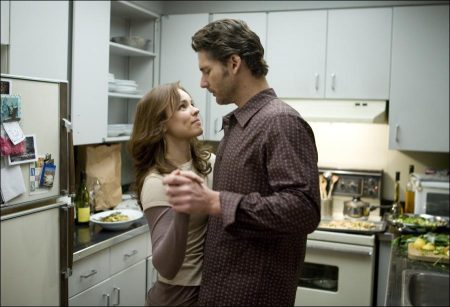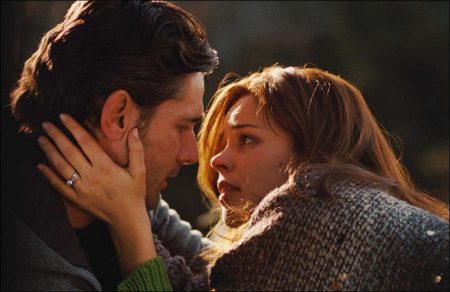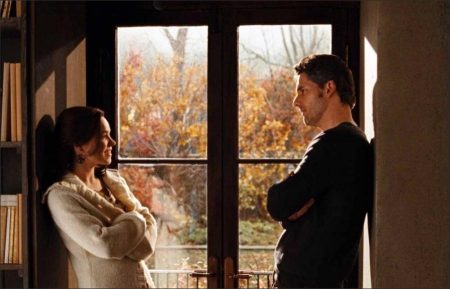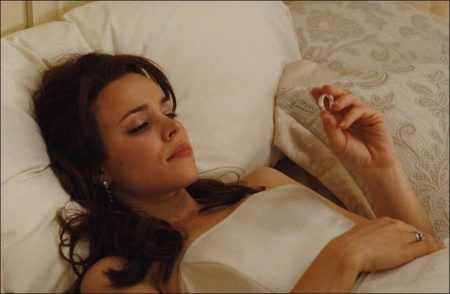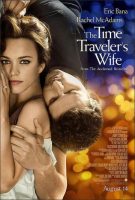I’ve never wanted to have anything in my life I couldn’t stand losing. But it’s too late for that now…I don’t feel alone anymore. – Henry
The Time Traveler’s Wife Movie Trailer. At the center of the romance are Clare and Henry, two people who are somehow destined to be together despite the intractable forces of time. Cast as Clare, Rachel McAdams relates that she was first attracted to her role on the pages of the book. “I read the book a few years ago and thought it was such a beautiful love story, so when the movie came about I was very excited by the prospect of playing Clare.
I was so intrigued by the character. I loved that she is an artist, and I also found her to be full of fascinating contradictions: she’s very wise and at the same time a bit naïve; she seeks out the extraordinary-she falls in love with a time traveler-but she also desperately wants something stable in her life. And I think that progresses as the story goes on. She’s committed to this man and everything that comes with him, but she’s struggling to make a home and have a normal marriage.”
Wechsler recalls that when the filmmakers met with the actress, “She was incredibly insightful about Clare and we knew immediately that we wanted her for the role. Rachel also has this natural warmth and charisma that was so important for the part.” “With Rachel,” Schwentke notes, “there is something intangible that happens; she just glows. She’s so lovely; it takes your breath away. There is almost an alchemical reaction between her face and the camera.”
Chemistry was also key in the casting of Eric Bana to star opposite McAdams. “A love story obviously depends on the right two people; without the right chemistry it doesn’t work,” Wechsler affirms. “After meeting with Eric, our instincts were that he and Rachel would be a great combination, and they were.”
“When I met Eric, I thought he was a great fit for the role of Henry,” Schwentke states. “He is a terrific actor, and he is also a really good man. He’s honest and grounded and a great family man, and those are qualities I feel shine through in his performance and lend gravitas and pathos to Henry’s plight.”
Bana says that the opportunity to work with both McAdams and Schwentke was part of what drew him to the project. “I’ve been a fan of Rachel’s and wanted to do a movie with her. I had also seen some of Robert’s work and thought he was a really interesting director, both visually and stylistically. We had a good chat about how we each saw the film and his interpretation of the material and I came away really excited about playing Henry.”
For the actor, the appeal of playing a time traveler was that the character is innately multi-faceted, appearing at various ages and shaped by his experiences, past, present and future. “It gave me room to make choices about what was right for the role at different times,” Bana explains. “We all change over time; none of us is the same person we were ten years ago. Life makes an imprint on us-how we behave, how much patience we have, how forgiving we are, how stubborn… So playing Henry at different ages allowed me to explore different sides of the same person and the impact on his relationship with Clare.”
Because the romance between Clare and Henry does not progress along a linear timeline, Robert Schwentke first engaged McAdams and Bana in a rehearsal period so they could break down the relationship between the characters at each stage. The director says, “Those weeks were spent examining each scene and translating the time travel into specific behaviors and everyday conflicts. So time travel is the crucible, but the emotional truth in the scenes is grounded. It was also a chance for all of us to become connected before our first day on the set.”
Both actors appreciated the added time together. “I think rehearsal periods are a huge benefit,” Bana attests. “I always use rehearsal times to learn how my cast-mates like to work. Rachel was incredibly easy to work with. She came into rehearsals extremely well-prepared; she knew the material very well and had very clear ideas, but never at the expense of other actors. She’s so natural and was always right there in the moment, which made my job so much easier. She is just brilliant.”
Rachel McAdams has equal praise for her leading man. “Eric is one of the most generous actors I’ve ever worked with. He’s a wonderful listener and he’s very patient and supportive; he’s someone you can lean on in a scene. And he’s also a lot of fun to be around. I had a great time working with him. I couldn’t have asked for a better time-traveling husband,” she laughs.
For obvious reasons, Clare had never confided in anyone that the love of her life was a time traveler, so the strange behavior of her new boyfriend is initially cause for some suspicion from her closest friend, Gomez, played by Ron Livingston.
“I’ve been a huge fan of Ron Livingston’s for a long time, so I was thrilled to cast him in the role of Gomez,” Schwentke comments. “I wanted someone who had dramatic chops, but at the same time possessed great comedic timing and that is Ron.”
When Henry tells Gomez about his condition, Gomez understandably thinks he’s crazy…until Henry vanishes right in front of his eyes. Gomez’s incredulity and mistrust eventually give way to a lifelong friendship with Henry.
Livingston says, “Ultimately, Gomez and Henry find common ground in how much they care for Clare. Henry needs someone to be there when he can’t, and Gomez is that guy. But Henry and Clare have a truly special relationship. Their fates are intertwined in a way that few people can understand.”
What’s wrong with my wanting one normal thing in my life? – Clare
The one thing that Clare desires most is to have Henry’s child, wanting to have some semblance of a normal family. But Henry resists, afraid that he will pass on his genetic anomaly to his child and knowing the rift his time traveling has caused between him and his own father.
Arliss Howard appears as Henry’s father, Richard DeTamble, who has a difficult time accepting his son’s condition, not because of what Henry does but because of what he can’t do-save his mother, Richard’s wife, who died in a horrific car crash when Henry was six years old. Henry, who was in the car, survived because he time traveled at the moment of impact. Though he has returned to that instant and witnessed the accident many times over, Henry is never able to undo the past.
“The fact that he can’t change anything constantly reminds him of how powerless he is in the situation,” says Dede Gardner. “It’s far more terrible than frustration because it never permits time to heal your wounds. Worse, time perpetuates them because you keep going back.”
As Henry explains to Clare, time is “like gravity. Big events pull you in.” Schwentke offers, “It means that he mostly travels to the formative moments of his life, the most formative, of course, being the death of his mother and meeting Clare in the meadow.”
“It’s great when you have an opportunity to direct actors you’ve always admired,” Schwentke says. “I grew up a cinephile in Germany and I remember seeing Arliss and Stephen in movies and loving their performances and choices. Then one day you get to work with them and that’s a wonderful gift.”
The cast of “The Time Traveler’s Wife” also features several talented young actors. Brooklynn Proulx plays the young Clare, who first encounters Henry in the meadow behind her house. Alex Ferris is seen as the young Henry. Sisters Hailey and Tatum McCann play Clare and Henry’s daughter Alba at ages ten and five, respectively. We’re home. See the garage out there?
That’s your studio. – Henry
“The Time Traveler’s Wife” is set in Chicago, and production did travel to the Windy City to film some exteriors and establishing shots. However, the majority of principal photography was accomplished in Toronto. In keeping with the elusive nature of time in the movie, production designer Jon Hutman says the settings needed to have a timeless feeling. “We wanted to create a sense of time being fluid, because that is Henry’s experience of time and consequently Clare’s experience of time and place. So there is a timeless quality to the movie; there is a flow to how their story unfolds. We mainly tried to capture three significant chapters in their lives.”
The first chapter was, of course, in the meadow where the couple initially met. Location manager Don Cornelius says that the meadow they chose had to meet certain criteria. “It had to seem like it was just over the hill from Clare’s parents’ house and yet feel like it’s Clare and Henry’s own world…a magical place.”
In addition, the open area of the meadow also had to be surrounded by trees that serve to camouflage Henry when he first appears. They found the perfect spot on a privately owned estate about 45 minutes out of Toronto. To make it look more natural, the filmmakers had the area irrigated and asked that it not be mowed so it would be lush and overgrown.
The next chapter of Clare and Henry’s lives begins in the library where Henry works as the rare books librarian and, Hutman adds, “He can legitimately disappear in the stacks for hours and nobody notices he’s gone.” It is there that the adult Clare finally catches up with Henry and sets their future in motion. The production filmed those scenes in Toronto’s Osgoode Hall Law Library, which stood in for Chicago’s Newberry Library.
Henry also brings Clare to his apartment in the city, which reflects his transient lifestyle. Hutman remarks, “It looks like he’s just moved in or is about to move out; his stuff is all in boxes and bags. It’s also a big apartment complex, where he can live in anonymity. The idea is that, as a time traveler, he’s a guy who has no friends, no roots.”
As Clare and Henry build a life together, they also find their dream home, which marks the third chapter in their lives. “Robert (Schwentke) did not want to lose the sense of the city entirely, so the idea was that the dream house would be a sanctuary in the city,” Hutman continues.
Cornelius says they found exactly what they were looking for in a house that had been converted from a rectory of a church in the 1880s. “It’s a big, beautiful old house with a wall around a garden courtyard. It’s a timeless place in the middle of the city.” Hutman and his team then created the interior of the house on a stage.
“Timeless” was the operative word for the film’s creative team. Schwentke explains, “We downplayed any period-specific aspects of the costume and set design so they would not draw attention. Everything in the frame is appropriate to the time, but we didn’t highlight any of it.”
The director also reveals that they wanted the story to echo Henry’s journey- moving from fragmentation to wholeness. He offers, “The movie is intentionally fragmented at the beginning, mirroring the state of Henry’s life. Then, after he finds Clare their relationship becomes Henry’s anchor. Things are more settled, which we tried to echo cinematically. In a way, the rhythms of their life dictated the rhythms of our film. Those shifts should be subtle, but hopefully they have a cumulative effect.”
Throughout the film, color was also an integral element of the design and Schwentke worked with Hutman and cinematographer Florian Ballhaus to use color as a subtle reflection of Henry’s state of mind. “In the beginning, the colors are vibrant,” the director notes, “but as Henry’s life calms down and he and Clare settle in their new home, the colors become more muted.”
Hutman reveals that the color red was also symbolically used in the design of the film. “We used red to foreshadow death,” he explains. “For example, before the accident in which Henry’s mother is killed, you see a red traffic light, you see the waving Santa in the red suit. Red comes in at a few other key moments, some of which won’t be clear until you get to the end. But we went to great pains to avoid red in the rest of the film. It’s hard to do Christmas season scenes without red, by the way,” he smiles.
Schwentke points out, “Our structuring principle was the seasons, in keeping with the cyclical nature of life. The movie progresses from winter to spring, summer, fall and then back to winter. That was one of the most challenging things because not only did we have to juggle the various years, but we also had to make sure we didn’t have the wrong season-you can’t have fall follow winter.”
Costume designer Julie Weiss affirms that the seasons were also essential to her designs. “That was something Robert emphasized over and over again: the seasons are a timeline.”
I’m a time travler. I come from the future and when I do, I don’t get to bring my clothes. – Henry
Weiss created Clare’s costumes to reflect her artistic nature. “With a character like Clare, who is an artist, a painter, the rules are thrown out. The way she dresses is not according to someone else’s idea of fashion,” Weiss states.
Rachel McAdams says she loved working with Weiss to enhance her character. “Julie looks for plot points to help build your look,” the actress attests. “She is so detail-oriented. She would plant little seeds to go along with the costume. It was never anything overbearing; it was just these light touches that added to the whole person. She has an eye for color and an artistic flair, which I think was really important for Clare.”
The rules were also different when it came to Henry’s costumes because when Henry time travels his clothes stay behind. When he reappears, he is naked and what he is forced to wear is often catch as catch can. Weiss expounds, “Wherever Henry appears, he immediately has to find clothes and he has to beg, borrow or steal what he can get.
Sometimes, he can blend in and other times what he’s wearing makes him stand out, to say the least. It doesn’t matter what he has on, the most important thing is for him to cover up and keep going.”
One aspect of Henry’s look was much more distinct. The length and color of his hair establishes the age at which the character appears in any given scene. Schwentke illustrates, “The young Henry has longer hair and the older Henry is short-haired with a touch of gray. And the gray increases, depending on his age. I think we had six iterations of hair for him.”
Dede Gardner teases, “At one point I called Robert and told him he had to map it out for me. It was a puzzle.”
Bana jokes that he had a foolproof way to keep his character’s age straight. “When I had the wig on, I knew I was playing the younger Henry and when I had my own hair, I was playing the older Henry. So that wig was a great physical tool for me,” he laughs.
I have to leave now. But I’ll come back. Lots of times. I’m going to take care of you the best I can. – Henry
To achieve the physical manifestation of Henry’s time travel, Schwentke worked with digital effects supervisor Jamie Hallett and his team to develop how the character disappears. “We wanted to find a way to convey what the experience is like for the character-like something is taking over,” the director elaborates. “It is something he has no control over; it controls him. The final effect is also meant to be reminiscent of sand dissolving through an hourglass.”
Nick Wechsler relates, “I think everyone wonders what it would be like to time travel-to know what is going to happen in the future or go back and revisit aspects of your life or people you’ve known in the past.”
“I think it’s wish fulfillment, the idea that you can go back and, in hindsight, make a better choice or benefit from something you know now that you didn’t know back then,” Schwentke reflects. “But there is a built-in paradox with all time travel stories. I hope the emotional impact of this story carries us through the paradox.”
The Time Traveler’s Wife (2009)
Directed by: Robert Schwentke
Starring: Eric Bana, Rachel McAdams, Ron Livingston, Jane McLean, Michelle Nolden, Arliss Howard, Katherine Trowell, Matt Birman, Brooklynn Proulx, Carly Street, Bart Bedford, Fiona Reid, Maggie Castle
Screenplay by: Jeremy Leven, Bruce Joel Rubin
Production Design by: Jon Hutman
Cinematography by: Florian Ballhaus
Film Editing by: Thom Noble
Costume Design by: Julie Weiss
Set Decoration by: Patricia Cuccia
Art Direction by: Peter Grundy
Music by: Mychael Danna
MPAA Rating: PG-13 for thematic elements, brief disturbing images, nudity and sexuality.
Distributed by: New Line Cinema
Release Date: August 14, 2009
Views: 133
